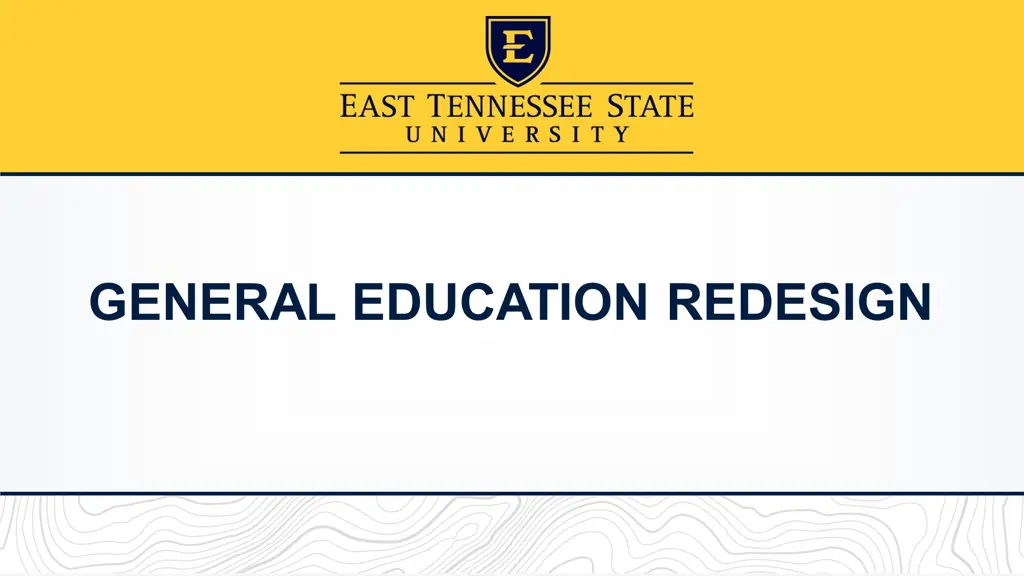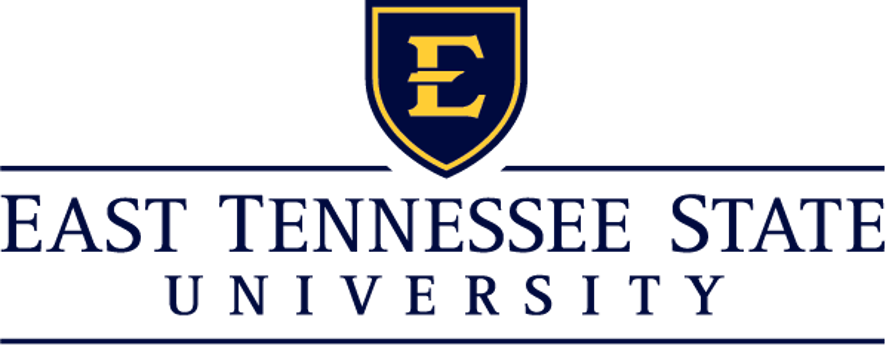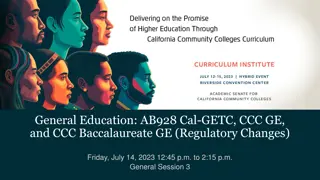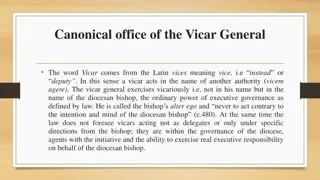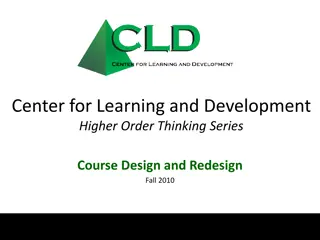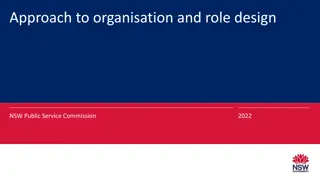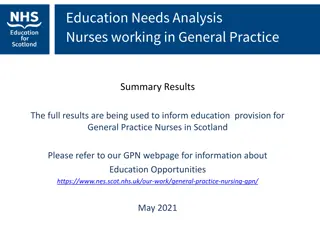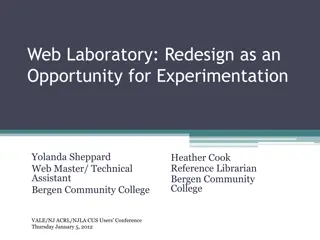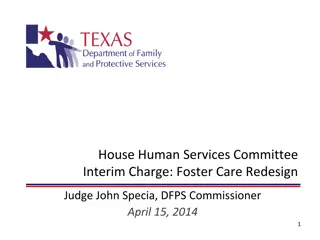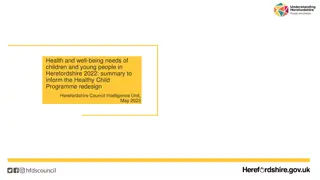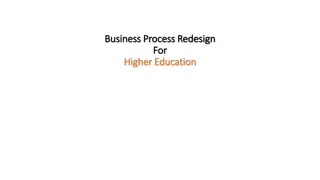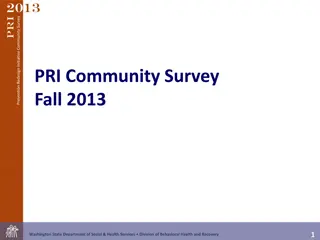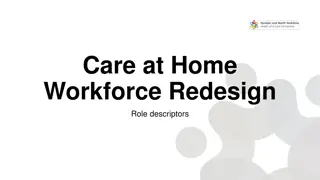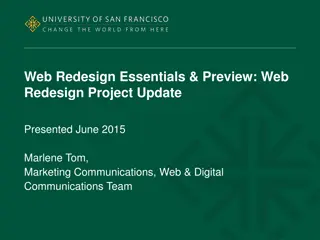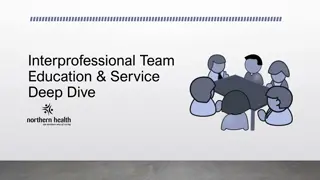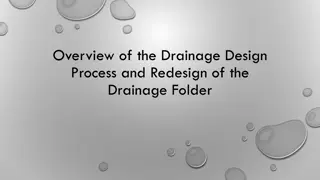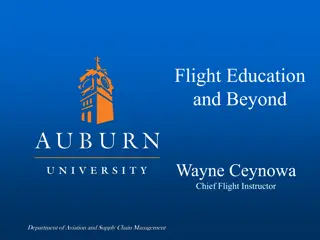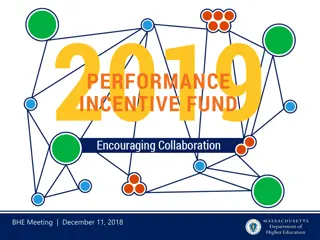General Education Redesign
The process of developing the proposed plan for a redesigned general education curriculum. Explore the first-year experience, strengthening foundational skills, understanding physical and social worlds, and cultivating aesthetic awareness. Gain knowledge in critical thinking, quantitative reasoning, and exploring connections. Develop as an individual and global citizen through this new educational approach.
Download Presentation

Please find below an Image/Link to download the presentation.
The content on the website is provided AS IS for your information and personal use only. It may not be sold, licensed, or shared on other websites without obtaining consent from the author.If you encounter any issues during the download, it is possible that the publisher has removed the file from their server.
You are allowed to download the files provided on this website for personal or commercial use, subject to the condition that they are used lawfully. All files are the property of their respective owners.
The content on the website is provided AS IS for your information and personal use only. It may not be sold, licensed, or shared on other websites without obtaining consent from the author.
E N D
Presentation Transcript
Process of developing proposed plan In early May, the Task Force (TF) reviewed public comments and revised competencies In late May, TF examined GenEd at other institutions peer, other TN institutions, and exemplary models Each TF member designed a GenEd plan and presented to entire TF in June/July. After presentations, TF analyzed plans, finding common themes/ideas, considering options, reaching out to institutions that had implemented certain aspects (e.g., themes). TF developed the proposed plan, reviewed and discussed it, and reached consensus.
FIRST-YEAR EXPERIENCE (3-4 credit hours) STRENGTHENING FOUNDATIONS (12-13) Writing (6) Quantitative Reasoning (3-4) Critical Thinking (3) UNDERSTANDING PHYSICAL AND SOCIAL WORLDS (10-11) Natural Sciences (at least 4) Social/Behavioral Sciences (at least 3) EXPLORING CONNECTIONS (9-10) History (at least 3) Humanities outside of History (at least 3) CULTIVATING AESTHETIC AWARENESS (3-4) GROWING AS AN INDIVIDUAL AND GLOBAL CITIZEN (3-4)
Content Wellness ETSU Resources Values of education FIRST-YEAR EXPERIENCE (3-4) STRENGTHENING FOUNDATIONS (12-13) Writing (6) Quantitative Reasoning (3-4) Critical Thinking (3) First-Year Experience UNDERSTANDING PHYSICAL AND SOCIAL WORLDS (10-11) CBAT and Honors provide models Subcommittee under construction, to be charged with developing this aspect of the proposal further. Natural Sciences (at least 4) Social/Behavioral Sciences (at least 3) EXPLORING CONNECTIONS (9-10) History (at least 3) Humanities outside of History (at least 3) CULTIVATING AESTHETIC AWARENESS (3-4) GROWING AS AN INDIVIDUAL AND GLOBAL CITIZEN (3-4)
FIRST-YEAR EXPERIENCE (3-4) Information literacy Argument structure Cognitive biases Source reliability Misinformation STRENGTHENING FOUNDATIONS (12-13) Writing (6) Quantitative Reasoning (3-4) Critical Thinking (3) First-Year Experience UNDERSTANDING PHYSICAL AND SOCIAL WORLDS (10-11) Natural Sciences (at least 4) Social/Behavioral Sciences (at least 3) EXPLORING CONNECTIONS (9-10) History (at least 3) Humanities outside of History (at least 3) CULTIVATING AESTHETIC AWARENESS (3-4) GROWING AS AN INDIVIDUAL AND GLOBAL CITIZEN (3-4)
FIRST-YEAR EXPERIENCE (3-4) Competency based STRENGTHENING FOUNDATIONS (12-13) The proposed curriculum was designed explicitly to meet the competencies that campus had reviewed. Writing (6) Quantitative Reasoning (3-4) Critical Thinking (3) First-Year Experience UNDERSTANDING PHYSICAL AND SOCIAL WORLDS (10-11) Natural Sciences (at least 4) Social/Behavioral Sciences (at least 3) THINK CRITICALLY COMMUNICATE EFFECTIVELY UNDERSTAND SOCIAL AND PHYSICAL WORLDS CULTIVATE AESTHETIC AWARENESS COLLABORATE AND BUILD COMMUNITY GROW AS A RESPONSIBLE AND PRODUCTIVE CITIZEN EXPLORING CONNECTIONS (9-10) History (at least 3) Humanities outside of History (at least 3) CULTIVATING AESTHETIC AWARENESS (3-4) GROWING AS AN INDIVIDUAL AND GLOBAL CITIZEN (3-4)
FIRST-YEAR EXPERIENCE (3-4) Greater flexibility STRENGTHENING FOUNDATIONS (12-13) The proposed curriculum gives students greater autonomy to pursue what interests them Writing (6) Quantitative Reasoning (3-4) Critical Thinking (3) First-Year Experience UNDERSTANDING PHYSICAL AND SOCIAL WORLDS (10-11) Natural Sciences (at least 4) Social/Behavioral Sciences (at least 3) EXPLORING CONNECTIONS (9-10) History (at least 3) Humanities outside of History (at least 3) CULTIVATING AESTHETIC AWARENESS (3-4) GROWING AS AN INDIVIDUAL AND GLOBAL CITIZEN (3-4)
FIRST-YEAR EXPERIENCE (3-4) More courses STRENGTHENING FOUNDATIONS (12-13) Although not reflected in the table, the Task Force concluded that General Education at ETSU should give students more choice through larger numbers of courses Writing (6) Quantitative Reasoning (3-4) Critical Thinking (3) First-Year Experience UNDERSTANDING PHYSICAL AND SOCIAL WORLDS (10-11) Natural Sciences (at least 4) Social/Behavioral Sciences (at least 3) EXPLORING CONNECTIONS (9-10) History (at least 3) Humanities outside of History (at least 3) CULTIVATING AESTHETIC AWARENESS (3-4) GROWING AS AN INDIVIDUAL AND GLOBAL CITIZEN (3-4)
FIRST-YEAR EXPERIENCE (3-4) Continuities with current curriculum eases transfer concerns STRENGTHENING FOUNDATIONS (12-13) Many transfer students will find that their courses can satisfy requirements within the revised curriculum Writing (6) Quantitative Reasoning (3-4) Critical Thinking (3) First-Year Experience UNDERSTANDING PHYSICAL AND SOCIAL WORLDS (10-11) Natural Sciences (at least 4) Social/Behavioral Sciences (at least 3) EXPLORING CONNECTIONS (9-10) History (at least 3) Humanities outside of History (at least 3) CULTIVATING AESTHETIC AWARENESS (3-4) GROWING AS AN INDIVIDUAL AND GLOBAL CITIZEN (3-4)
FIRST-YEAR EXPERIENCE (3-4) Badges STRENGTHENING FOUNDATIONS (12-13) Also not reflected in the table is the hope that students will choose to earn badges, by taking several courses that explore a common theme from distinct humanistic, scientific and/or artistic perspectives. Writing (6) Quantitative Reasoning (3-4) Critical Thinking (3) First-Year Experience UNDERSTANDING PHYSICAL AND SOCIAL WORLDS (10-11) Natural Sciences (at least 4) Social/Behavioral Sciences (at least 3) Potential badge topics: EXPLORING CONNECTIONS (9-10) History (at least 3) Humanities outside of History (at least 3) Appalachian Studies Environmental Studies Health and Wellness Religious Studies War and Peace Justice and ethics CULTIVATING AESTHETIC AWARENESS (3-4) GROWING AS AN INDIVIDUAL AND GLOBAL CITIZEN (3-4)
As part of the proposal, we suggest that all general education courses should utilize at least one high-impact practices. FIRST-YEAR EXPERIENCE (3-4) STRENGTHENING FOUNDATIONS (12-13) Writing (6) Quantitative Reasoning (3-4) Critical Thinking (3) High impact practices can be large or small-scale, ranging from problem-based learning activities during class sessions to more formalized activities. Below is a non-exhaustive list of possible HIPs: First-Year Experience UNDERSTANDING PHYSICAL AND SOCIAL WORLDS (10-11) Natural Sciences (at least 4) Social/Behavioral Sciences (at least 3) Learning Communities Writing-Intensive Courses Collaborative Assignments & Projects Problem-based assignments Project-based assignments Informal small group work Reflective practices Community-engaged Learning EXPLORING CONNECTIONS (9-10) History (at least 3) Humanities outside of History (at least 3) CULTIVATING AESTHETIC AWARENESS (3-4) GROWING AS AN INDIVIDUAL AND GLOBAL CITIZEN (3-4)
FIRST-YEAR EXPERIENCE (3-4) STRENGTHENING FOUNDATIONS (12-13) Writing (6) Quantitative Reasoning (3-4) Critical Thinking (3) What next? Gather feedback Streamline approval process Collaborate for FYE courses Plan for meetings with departments/units Recommend new courses Recommend badges Plan for faculty development Undertake impact on college budgets First-Year Experience UNDERSTANDING PHYSICAL AND SOCIAL WORLDS (10-11) Natural Sciences (at least 4) Social/Behavioral Sciences (at least 3) EXPLORING CONNECTIONS (9-10) History (at least 3) Humanities outside of History (at least 3) CULTIVATING AESTHETIC AWARENESS (3-4) GROWING AS AN INDIVIDUAL AND GLOBAL CITIZEN (3-4)
